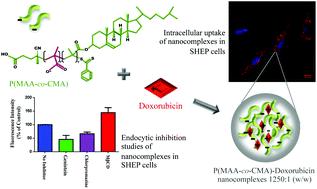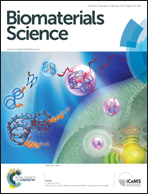The endocytic pathway and therapeutic efficiency of doxorubicin conjugated cholesterol-derived polymers†
Abstract
Previously synthesized poly(methacrylic acid-co-cholesteryl methacrylate) P(MAA-co-CMA) copolymers were examined as potential drug delivery vehicles. P(MAA-co-CMA) copolymers were fluorescently labelled and imaged in SHEP and HepG2 cells. To understand their cell internalization pathway endocytic inhibition studies were conducted. It was concluded that P(MAA-co-CMA) are taken up by the cells via clathrin-independent endocytosis (CIE) (both caveolae mediated and cholesterol dependent endocytosis) mechanisms. The formation and characterization of P(MAA-co-CMA)–doxorubicin (DOX) nanocomplexes was investigated by fluorescence lifetime imaging microscopy (FLIM), UV-Visible spectroscopy (UV-Vis) and dynamic light scattering (DLS) studies. The toxicity screening between P(MAA-co-CMA)–DOX nanocomplexes (at varying w/w ratios) and free DOX, revealed nanocomplexes to exhibit higher cytotoxicity towards cancer cells in comparison to normal cells. FLIM and confocal microscopy were employed for investigating the time-dependent release of DOX in SHEP cells and the cellular uptake profile of P(MAA-co-CMA)–DOX nanocomplexes in cancer and normal cell lines, respectively. The endocytic pathway of P(MAA-co-CMA)–DOX nanocomplexes were examined in SHEP and HepG2 cells via flow cytometry revealing the complexes to be internalized through both clathrin-dependent (CDE) and CIE mechanisms. The drug delivery profile, reported herein, illuminates the specific endocytic route and therapeutic efficiency of P(MAA-co-CMA)–DOX nanocomplexes strongly suggesting these particles to be promising candidates for in vivo applications.


 Please wait while we load your content...
Please wait while we load your content...